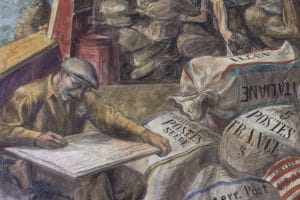By Seamus O’Malley
The novelist of epistemological crisis would have had something to say about Artificial Intelligence.
In The Good Soldier Dowell asks: “If for nine years I have possessed a goodly apple that is rotten at the core and discover its rottenness only in nine years and six months less four days, isn’t it true to say that for nine years I possessed a goodly apple?” Is thinking the same as knowing? Dowell seems to know—and Ford does know—that there is a gap between reality and our thoughts about reality. As a result of this basic fact, Dowell, like the rest of us, is never quite sure what he knows. AI, by contrast, always delivers its supposed truths with the same bland assurance, blithely citing non-existent sources in a process misnamed “hallucination.” Since it doesn’t know what it is to know something, it’s not smart enough to angst about not knowing.
AI is better at doing than knowing, good at speeding up mundane tasks, and while we’ve been promised a bounty of scientific advances, so far the fruits of AI seem to be cheating undergraduates and stories of people marrying bits of software. Yet there is one way that it has made my life easier: it helps me decipher Ford Madox Ford’s handwriting.
As part of Oxford University Press’s Complete Works of Ford Madox Ford, I am currently editing the Fifth Queen trilogy. There have been several editions over the years but never a critical volume, so my first task is to track the variations from the handwritten manuscripts against the published text. I secured a grant from my school that came with a student assistant, but rather than put her on the manuscript, I assigned her the work of getting the published text into usable form. For the handwriting I tapped Transkribus.
Transkribus is artificially intelligent transcription software. Optical Character Recognition (OCR) has long existed but can only decipher a limited number of printed fonts. The scribblings of humans require a more sophisticated approach, and the Transkribus software “learns” over time how to interpret handwriting. When you start a project you select whichever premade “model” is most applicable. Models include “Old Czech Handwriting (with spaces)”, “Spanish Gothic Print v2”, “Latin Humanisitic manuscript 17th century”, etc. But that’s just your baseline. From there you start training the model for your specific task. You do so via your own transcriptions, showing the software what a correct transcription looks like. It starts to learn, and then you start to create your own model, and the software uses that as its new interpretive basis. At first it will still be quite inaccurate, but you correct it, and from that point on, the more you use and correct it the “smarter” it gets. (If I can get my Ford model smart enough I can make it public, hopefully soon. Predictably, the Joyceans were there first: there are already “Joyce early letters” and “Joyce middle letters” language models.)
It’s hard to measure how much time is saved by using AI. There’s a good deal of labor upfront training the model, then the middle part of the project is done lightning-fast. But the last phases of transcription require the return of human intelligence. It takes a person to know what to do when Ford writes six periods in a row. AI thinks it’s a sloppy ellipsis and renders any multiple of dots as three, whereas Ford clearly saw a difference between three dots and six, four dots and seven.
There are also things simple, even obvious to the human eye, that AI struggles with. Transkribus does great with writing done on a straight line. But those chunks of words in the margin, with a long, winding arrowed line that we learned to do as kids, flummoxes the software.
Tools like Transkribus will, no doubt, eventually learn how to handle such variations on word arrangement. But for now I don’t begrudge the labor required to finish off the transcription process, because it’s in such idiosyncratic use of ink on paper that I feel closest to Ford himself. There’s a thrill, in transcribing, when you can tell that the author has changed or refilled his pen—you’re right over their shoulder, you feel more like amanuensis than transcriber. Even before the rewarding labor of interpretation—that’s for next year—there is a joy in watching the miracle of artistic birth. Somehow ink generates Katharine Howard and Throckmorton arguing in a gully outside Tudor London. AI will never fully know that, but it’s hard to wrap my human head around it as well.







